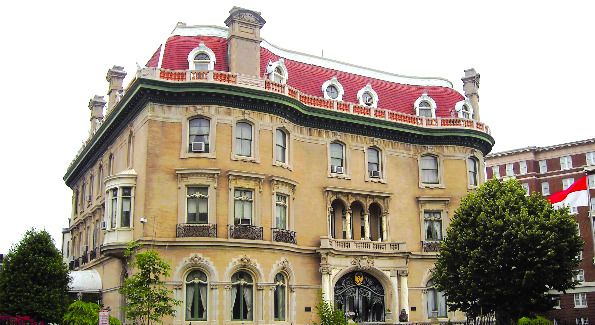Grand mansions built for Gilded Age plutocrats are the nucleus of the capital’s embassy district.
By Donna Evers

This magnificent mansion- originally the home of Thomas Walsh- is now the home of the Indonesian Embassy
Embassy Row symbolizes the height of Washington elegance, but it wasn’t always that way. In the 1880s, much of the area west of Dupont Circle was marshland used as a city dumping ground.
When the city’s first mayor, the notorious Boss Shepherd, bought property there, speculators followed suit, convinced that paved streets and gas lines would soon follow. They were right. When these ambitious businessmen began building their mansions in the midst of a wasteland, a local publication described the scene as follows: “Everywhere there are superb residences looking out upon fields of red clay and weeds, and flanked on either side by shanties …”
The new neighborhood caught on, and by 1900 it had already been dubbed “Millionaires’ Row.” Captains of industry from Chicago, Pittsburgh, and Cincinnati, many of whom couldn’t break into the closed society of New York and Newport, moved to the nation’s capital where they could create a stir simply by owning an opulent house and throwing lavish parties (while lobbying for their railroads, coal mines, and factories back home). American aristocrats like Henry Adams and John Hay, installed around Lafayette Square, viewed the palatial new homes as the epitome of nouveau riche excess. Luckily, however, there happened to be a crop of stellar young architects in Washington at the time, including many who had trained at the prestigious L’École des Beaux Arts in Paris.
The houses they were commissioned to design, grounded in elegant European traditions, were nothing short of brilliant.
Among the new millionaires was Thomas Walsh, an Irish immigrant who struck gold in Colorado and then commissioned one of the largest houses ever built in Washington at 2020 Massachusetts Ave. NW (now the Indonesian Embassy). Richard and Mary Townsend, who possessed two Pennsylvania railroad fortunes, built a copy of Versailles’ Petit Trianon at 2121 Massachusetts Ave. NW (now the Cosmos Club). Gas and coal magnate Clarence Moore, who later perished on the Titanic, had Jules Henri de Sibour, a graduate of the École in Paris, design a perfectly balanced Beaux Arts creation at 1746 Massachusetts Ave. NW that later became Embassy of Uzbekistan.
Edward Hamlin Everett, who invented the crimped bottle cap for Coca Cola, asked George Oakley Totten Jr., another École student, to design his magnificent home off Sheridan Circle at 1606 23rd St. NW (now the Turkish Ambassador’s residence). A few steps away, the Alice Pike Barney House on Sheridan Circle later became the Latvian Embassy; Mrs. Barney’s father got rich distilling whiskey, and she had Waddy B. Wood design an Art Nouveau haven to serve as a salon for artists and musicians.
At 2315 Massachusetts Ave. NW, George Oakley Totten Jr. created another beautiful Beaux Arts pile, which the Embassy of Pakistan now occupies. Next door (2311 Massachusetts Ave. NW) is the classic masterpiece Nathan C. Wyeth designed for New York financier Gibson Fahnestock, now home to the Embassy of Haiti. At 3000 Massachusetts Ave. NW, a fine Roman palazzo built by the heir of the McCormick reaper fortune (currently the Brazilian Embassy residence. Its designer, John Russell Pope, was also responsible for the Jefferson Memorial and the National Gallery of Art.
The majestic British Embassy (3100 Massachusetts Ave. NW) was the creation of Sir Edwin Lutyens, who built it on ground donated by famed Washington builder Harry Wardman. As a teenager, Wardman, who was born into poverty in England, stowed away on a ship to America and made a fortune building numerous townhouses, apartment buildings, and hotels throughout Northwest Washington. The Great Depression signaled the end of the Gilded Age in Washington. Many of the colossal homes’ owners lost their fortunes. Embassies were the only buyers who could still make use of the vast ballrooms and servants’ quarters. Even the indomitable Wardman went bankrupt.
The era of great mansion building is long gone, but we continue to enjoy the legacy of dozens of beautiful buildings that are part of the capital’s unique landscape and storied diplomatic life.




